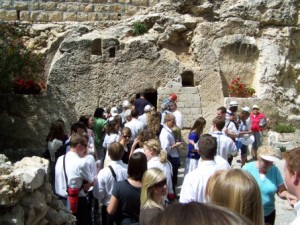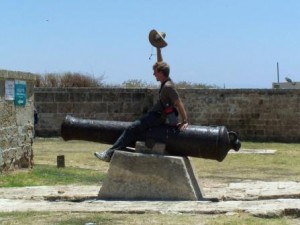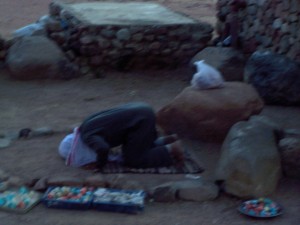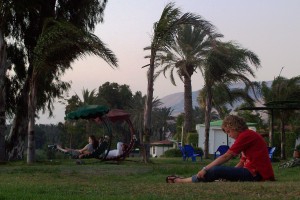Some years ago I found myself a student in the Holy Land (which you can see on this blog). For four months I wandered from church to church; Jewish, Muslim, Christian; taking pictures, reading scriptures, and being enchanted by a global mix of cultures and traditions and faith all mashed into an ancient city and land. The places were so sacred that people traveled thousands of miles to visit and pray there. Many Catholics came from South America. Muslims came from all over the Middle East. Orthodox Christians came from Africa, Russian, and Greece. Jews came from New York. Europeans came to hike the mountains and snap pictures of all the praying people.
And there I was. I was a student. Not a Pilgrim. Not a tourist. Not a dignitary. Not a solder. I had time to read and think and pray. And I watched these people from around the world and pondered. I was in a church at the Garden of Gethsemane snapping pictures of the stain glass windows when a group came in and knelt with complete reverence on the stone floor. A priest came out an started administering mass to the people who appeared to be from Brasil or something similar. It suddenly struck me that this strange ancient ornate building was a church. How would I feel if someone came into my temple and started snapping pictures with that disconnected entertain-me attitude that I so often had in these old churches?

This is a Protestant Christian site far from the actually site (probably) Lots of Pilgrims come here to rebaptize themselves.
I realized that in some places I was a tourist. I came to take pictures, make funny poses, and buy souvenirs so I could go home and brag to my friends about my visit to the tomb of some dead pharaoh. Merchants begged me for business. I took thousands of pictures. I read the tourist plaques and chatted about home with my companions. We made fun of the odd things we saw, either people from strange places or behaviors we didn’t understand. We wore clothing from the mall and looked like city slickers on a cattle drive.
In other places I wore Sunday clothes and brought my scriptures. Sometimes I went fasting and stared into the trees or rocks searching for some whisper of the carpenter who was once buried there. I would whisper quiet prayers or slip a written wish into a crack in the wall. Sometimes I would sit on fast Sundays watching tourists and pilgrims rustle by the ancient trees which perhaps were silent witnesses of a two thousand year old sacrifice. I can tell you that I value those experiences far beyond my tourist visits.
What makes the difference? How can two people visit the same place and experience it so differently? I don’t know how to be a pilgrim instead of a tourist. Even back home in Utah I frequently find myself pondering the question as I visit a national park or climb a mountain. Do I climb mountains as a tourist? To conquer the peak, to take fancy pictures, to secure bragging rights or likes on a facebook post? Or, as I usually tell people, do I embrace nature to recharge my soul, to find answers to hard questions, or escape from modern living for a few moments? Here are some observations, they may be wrong and they are certainly not the final word on the topic:
1. Tourists are concerned about making memories. They are on vacation. They want stories to bring home to tell their office mates. They want pictures to post on facebook and inside jokes they can laugh about later. They seek entertainment and distraction.
2. Pilgrims are seeking something. They are searching for a feeling, or inspiration, or communion with God. They go places to worship not to just see. There is a yearning in the soul they are trying to satisfy.
3. Tourists don’t see the meaning of things. They see only the surface, the art, the architecture, the statues, the mud in the street. They see locals as “them” and are eager to return back to their homes where everything is sane and right. The tourist lives correctly while the strangers live in odd convoluted ways.
4. Pilgrims stop and listen. They take time to pray, even in public. They may engage in religious ceremonies. They are visiting the event not just the place where the event took place. They see others as fellow participants in life. They see other humans like themselves, full of sorrow and trial and strife and fighting for a little more security in the world. Certainly there are differences in culture or language. But we are all in this together and each of us is on a private question for understanding in this world.
5. Tourists come home and brag about their experience. They tell friends and family about it. They put artifacts on their walls. Their journey is a trophy hunt, a monument to victory won.
6. Pilgrims come home changed. They have stored up spiritual understanding and uncovered hidden parts of themselves. They close their eyes and return not to the place but to the feeling of the place. They develop a spiritual insight into the world around them. They find inner peace.
Because I have pondered these things I desire to be more often a pilgrim and less often a tourist. It takes work. It adds meaning to experiences. It doesn’t mean you can’t take pictures but it changes your attitude towards a place. I’m not sure I have yet found the core of the distinction but I’m convinced that its worth the effort and I will keep working towards it
——
For more thoughts on this topic check out this news article:
http://www.deseretnews.com/article/765589691/A-sacred-journey-in-search-of-God.html?pg=all







Recent Comments